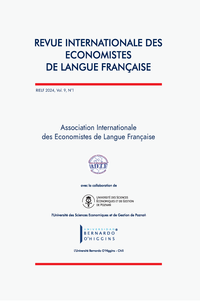Gender salary gap in the labor market in Cameroon: glass ceiling or sticky floor?
DOI:
https://doi.org/10.18559/rielf.2024.1.1640Keywords:
wage gap, gender, glass ceiling, sticky floor, discriminationAbstract
Purpose: This article aims to verify whether the sources of salary inequalities between women and men on the labor market in Cameroon result from the existence of a glass ceiling and/or a sticky floor.
Design/methodology/approach: The method chosen is that of quantile regressions supplemented by the quantile decomposition technique.
Findings: The results obtained support the existence of a sticky floor and reject that of a glass ceiling. They show that male/female wage inequalities decrease as we move up the wage distribution. At the top of the distribution, the wage gap to the detriment of women mainly finds its source in differences in observable individual characteristics, while at the bottom of the distribution, this gap is more due to factors exogenous to these observable characteristics.
Originality/value – Our paper highlights the fact that, in the labor market in Cameroon, the level of discrimination against women is a decreasing function of salary quintiles. Which is both an original result and at first glance paradoxical insofar as one would have expected that possible discrimination would be more significant at the level of the best paid jobs. Thus, women in Cameroon should aim to compete for highly paid jobs as there, they are less exposed to the risk of discrimination.
Downloads
References
1. Baye, F., Epo, N., & Ndenzako, J. (2016). Wage differentials in Cameroon: A gendered analysis. African Development Review, 28(1), 75–91.
View in Google Scholar
2. Becker, G. (1957). The economics of discrimination. University of Chicago Press.
View in Google Scholar
3. Becker, G. (1964). Human capital: A theoretical and empirical analysis, with special reference to education. University of Chicago Press.
View in Google Scholar
4. Buchinsky, M. (1998). Recent advances in quantile regression models: A practical guideline for empirical research. The Journal of Human Resources, 33(1), 88–126.
View in Google Scholar
5. Challe, L., Chareyron, S., L’Horty, Y., & Petit, P. (2020). Discrimination dans le recrutement des grandes entreprises: Une approche multicanale. TEPP Research Report 2020-01.
View in Google Scholar
6. De La Rica, S., Dolado, J., & Lorens, V. (2008). Ceiling or floors? Gender wage gaps by education in Spain. Journal of Population Economics, 21(3), 751–776.
View in Google Scholar
7. Di Paola, V., & Epiphane, D. (2023). Inégalités de genre en début de vie active, un bilan décourageant. Céreq Bref, 442, 1–4. https://doi.org/10.57706/cereqbref-0442
View in Google Scholar
8. Goldin, C., Kerr, S. P., & Olivetti, C. (2022). When the kids grow up: Women’s employment and earnings across the family lifecycle. NBER Working Paper, 30323.
View in Google Scholar
9. Havet, N., & Sofer, C. (2004). Écarts salariaux et disparités professionnelles entre sexes: Développements théoriques et validité empirique. L’Actualité Économique, Revue d’Ana- lyse Économique, 80(1), 4–39.
View in Google Scholar
10. INSEE. (2020). Écart de rémunération femmes-hommes: Surtout l’effet du temps de travail et de l’emploi occupé. Insee Première, 1803.
View in Google Scholar
11. Koenker, R. (2005). Quantile regression, econometric society monographs. Cambridge University Presse.
View in Google Scholar
12. Koenker, R., & Bassett, G. (1978). Régression quantiles. Econometrica, 46(1), 33–50.
View in Google Scholar
13. Lalive, R., Oesch, D., & Pellizzari, M. (2023). How personal relationships affect employment outcomes: On the role of social networks and family obligations. In D. Spini & E. Widmer (Eds.), Withstanding vulnerability throughout adult life: Dynamics of stressors, resources, and reserves (pp. 49–66). Palgrave Macmillan.
View in Google Scholar
14. Machado, J., & Mata, J. (2005). Counterfactual decomposition of changes in wage distributions using quantile regression. Journal of Applied Econometrics, 20(4), 445–465.
View in Google Scholar
15. Melly, B. (2006). Estimation of counterfactual distributions using quantile regression. Swiss Institute for International Economics and Applied Economic Research.
View in Google Scholar
16. Oaxaca, R., & Ransom, M. (1994). On discrimination and the decomposition of wage differentials. Journal of Econometrics, 61(1), 5–21.
View in Google Scholar
17. OIT. (2016). Women at work: Trends 2016. International Labour Organisation.
View in Google Scholar
18. Rosen, S. (1974). Hedonic prices and implicit markets: Product differentiation in pure competition. Journal of Political Economy, 82, 34–55. https://doi.org/10.1086/260169
View in Google Scholar
Downloads
Published
Issue
Section
License
Copyright (c) 2024 Georges Bertrand Tamokwé Piaptie, Fayllonne Marina Piame Njanpou

This work is licensed under a Creative Commons Attribution-NonCommercial-ShareAlike 4.0 International License.





